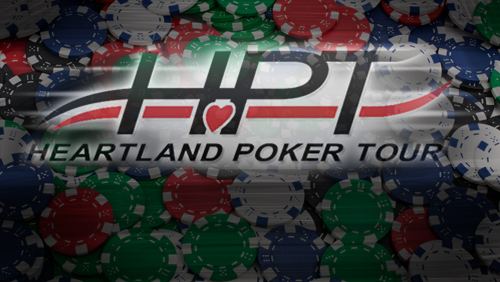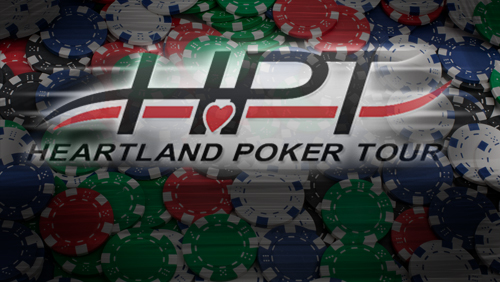The Heartland Poker Tour (HPT) is more than just a poker tour, it’s also a great business. People think that great businesses are created by great people, or great products, or fantastic numbers, or maybe even great slices of fortune. All of these assumptions are incorrect. Great businesses are created by great ideas and back in 2005 it was a great idea by two good friends Greg Lang and Todd Anderson that created a breeding ground for future World Series of Poker (WSOP) Champions.
 Their vision was to create a TV show about poker, but they had a problem. The WSOP and the World Poker Tour (WPT) had that market pretty much covered in the United States. Undeterred, Lang and Anderson realized that if they could make their TV show slightly different from the two big guns, then maybe their little air rifle would have a shot.
Their vision was to create a TV show about poker, but they had a problem. The WSOP and the World Poker Tour (WPT) had that market pretty much covered in the United States. Undeterred, Lang and Anderson realized that if they could make their TV show slightly different from the two big guns, then maybe their little air rifle would have a shot.
“We wanted a TV show focused on the average, ordinary player, something produced regionally and completely opposite of the glamorous poker shows that were around back then.” Says Anderson.
After a lot of pain and hard work the HPT was born, and by maintaining their unique differences, whilst also taking some of the great ideas from their competitors, they have managed to create a show that over the past eight years has been aired in over 100m homes in the United States, and in 20 European countries.
Both Lang and Anderson are both visionaries, but little did they know that their TV show would become a breeding ground for the future stars of poker. They knew that the amateur players would come for their chance to win some big money, and most importantly appear on TV; after all the shows slogan is ‘Real People, Unreal Money,’ but they had no idea they would become a conveyor belt of American talent.
In 2006, Michael Banducci was the runner-up in HPT Peshawbestown. It was just his second live cash of his career and he would go on to win a WSOP bracelet in 2008, when he defeated the young superstar, Jeff Williams, in heads-up action to win a $1k No-Limit Hold’em (NLHE) event for $636,736.
In 2008, a young player by the name of Dan Smith would walk into the card room at the Turning Stone Resort & Casino in Verona. A few days later and Smith was walking away with the first prize of $101,960. Five years later and Smith has turned that into $4.5m and is recognized as one of the world’s greatest live tournament players.
Jason DeWitt finished runner-up to Shane Sigsbee in the 2008 HPT event at the Majestic Star Casino in Gary for $103,136, and would pick up a WSOP bracelet in a $5k NLHE event at the 2010 WSOP for $818,959.
Also in that same year a young man called David Peters picked up a HPT title in Mount Pleasant for $130,178. Peters has since won $3.69m in live tournament poker and represents IveyPoker as a sponsored pro.
Andrew Lichtenberger is one of the most feared live tournament players around. The man known as luckychewy took fifth at the HPT NY Fall Poker Classic in Verona, back in 2008. The $18,620 he earned for that finish was the best of his career, at that time, and he has since gone on to win over $3.2m.
Two more 2008 HPT champions would go on and win WSOP bracelets in Dean Hamrick and Chris Dombrowski; John Beauprez would do likewise in 2010 & 2013, as would Trevor Pope in 2012 & 2013; and lest we not forget the countless number of former HPT finalists that also went on to win WSOPC gold rings.
In 2012, the HPT brand went supernova after Greg Raymer won four titles in a single season, an achievement that also won him the HPT Player of the Year title and cements his place as the highest money earner in the history of the HPT.
The only problem the HPT has is maintaining their status as the underdog. They have played their cards wisely with the addition of Darvin Moon as an ambassador. The man who won $5.18m in the 2009 WSOP Main Event, after qualifying through a $130 satellite, and then refusing to wear anybody’s logo at the final table because, “I don’t want a boss. I’ve come this far on my own. I don’t want to answer to anybody now,” is the archetypal underdog of poker and the pair is a perfect match, but Raymer’s hot streak and the economic problems that many professionals are facing mean more and more top professionals are turning to the HPT for their action.
Will ‘The Thrill” Failla took a HPT title in St Louis in 2012 for $119,064; former Nov Niner Phil Collins did likewise in 2012 in Las Vegas. An event that saw a final table comprised of Matt Marafioti (2nd), Steve Gross (3rd), Leo Wolpert (4th) and Dan O’Brien (5th) – nothing particularly average and ordinary about that.
WSOP bracelet winners David Baker, Chance Kornuth and Joe Cada have had deep runs in the past few seasons and Allen Kessler is currently third on the leader board. When you couple that to the inclusion of Maria Ho as the first female commentator ever in poker, and the inclusion of Daniel Negreanu as an advisory on 2013 structural changes, then you have a product that is starting to mirror the glamour and glitz that they were distancing themselves from when the concept was first conceived. When competitors all make their living in the same way, in the same place and at the same time, nobody is going to prosper.
At the moment it appears that maintaining the status quo seems to be the order of the day for the HPT. The decision to hold their events over the weekend so ordinary working class people don’t have to miss work is genius, the new structure means the play is superb, the $1,650 buy-in is respectable (although I think a tad high), the field sizes continue to grow, Maria Ho will bring sparkle to the live commentary and the regulars such as Craig Casino and Stan Jablowski will keep pushing their edges, only this time against some of the better players in the world.
What started out as a simple idea has stretched into one of the most loved poker tours in the United States. A tour for the common man, a chance to live the dream and a training ground for the WSOP champions of the future.
